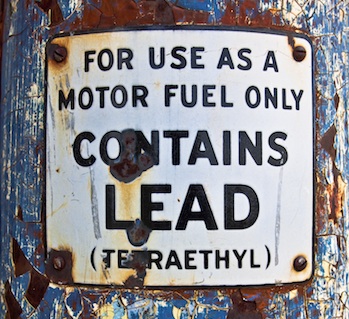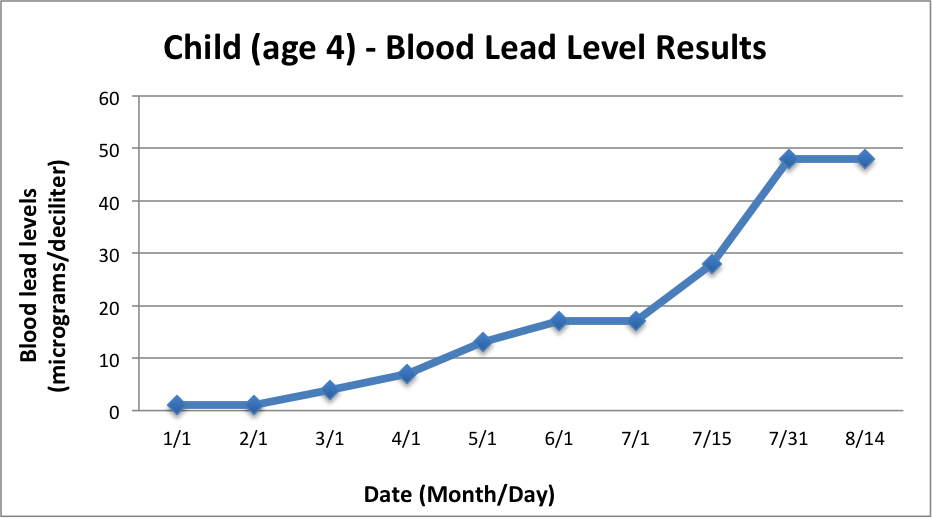
Chapter 23. Lead in our Lives
Lead in our Lives


Read the article below. Then complete the comprehension questions that follow.
Lead is both useful and toxic to humans
Lead is an inexpensive metallic element that is durable, resistant to corrosion, and malleable. Unfortunately, it’s also a toxin that can enter our bodies in tiny quantities, accumulate in our tissues, and cause great harm—particularly to our nervous system. Through this combination of usefulness and toxicity, lead has both helped and poisoned humans for thousands of years. Let’s see how lead has been useful, as well as how it can adversely affect our bodies.
Bullets, pipes, paints, and gas
Humans have found countless uses for lead throughout history. Ancient Egyptians mixed lead into pottery glazes, and Romans used it to make water pipes. Lead is in the stained glass windows that have graced churches since medieval times, as well as in the moveable type of printing presses that promoted literacy and free expression.
Considering all the people killed by them, lead bullets have also had an enormous impact on history—though generally the result of damage done to the body, and not because of lead’s toxicity. The toxicity of lead bullets can be a serious problem for other animals, however. (See the section on “Lead & Condors” below.)
Most of the toxicity of lead to the systems of the human body has come from three sources: pipes, paints, and gasoline. Lead was a common component of all three a little more than a generation ago.
The practice of making water pipes from lead far outlasted the Roman Empire. Lead was still being used for pipes well into the 20th century, and lead-based solder to join copper pipes was still used in the 1980s. For hundreds of years humans were ingesting toxic lead particles along with the water they drank from these pipes.
Lead was in paint for a long time, too. As recently as the 1970s, house paints contained lead, and undercoats of paint in many homes, schools, and workplaces still do. This puts children and pets—who spend much of their time on the floor where paint dust and chips land—at particular risk. Lead was even breathed in from the air. Tetraethyl lead was added to gasoline from the 1920s until the 1970s. The dangers of toxic emission created by leaded gas caused its gradual reduction and eventual banning.
Lead Paint in Toys
Lead most recently made the news when poisonings were linked to contaminated toys manufactured in China and sold in the United States. In 2007, toy manufacturers recalled more than one-million toys because of lead paint contamination.
How lead acts in the body

The dangers of lead have long been in evidence. The Greek physician Nikander described lead poisoning 2300 years ago, and historians tell us that Roman aristocrats suffered from psychosis and infertility—both symptoms of lead poisoning. But how does lead wreak havoc when it enters our bodies?
Lead is carried by the blood to soft tissue and bone where it can be stored for many years. Exposure can be harmful to several organs— including kidneys—as well as the nervous system. Long-term exposure to lead can cause memory loss and learning impairment. Recent studies have linked early childhood exposure to behavioral problems and juvenile delinquency. Death can result from sustained exposure.
Many of lead’s toxic properties stem from its ability to mimic calcium, altering cellular processes. Even at low concentrations, lead interferes with the release of neurotransmitters (chemicals used by the nervous system to communicate with nearby cells), especially in the brain. Star-shaped cells, called astrocytes, can be impacted by lead as well. Astrocytes help repair scarring in the brain and spinal cord and provide nutrients to nervous tissue. This is why lead poisoning in high doses can result in brain hemorrhaging.
Lead also interferes with the protective sheath that insulates nerve cells in the central nervous system, and alters the integrity of the blood-brain barrier. This damage can lead to severe impairment, especially in children. Tots with lead poisoning might complain of stomachaches and exhibit hyperactivity, sleeping problems, or irritability. Because these symptoms mimic other conditions, lead poisoning is sometimes mistaken for a cold or the flu.
Getting the lead out of your life
Conservation groups and public health department campaigns continue to warn the public about lead pollution. Even though the metal is now banned in pipes, paint, and most gasoline, many of us who live, work, and go to school in older buildings can come into contact with lead, and lead-contaminated soil lines many streets and roadways.
What can you do to reduce your exposure to lead? If you have doubts about the safety of your home or workplace, have tests done on the water and paint. Most importantly, watch for the warning signs of lead poisoning, especially in children. The only way to diagnose lead poisoning is by having a blood test, but treatment shortly after exposure can sometimes help prevent severe damage.
Lead & Condors
Even birds bite the lead bullet. Research recently proved that condors and other endangered birds consume tiny bits of lead-based ammunition when scavenging the remains of animals killed by shotguns. Also, animals can mistake spent shotgun pellets on the ground for seeds and consume them. This is a big problem since the ammunition most recreational shooters fire from their guns remains in the countryside.
In the winter of 2010 three endangered California condors died from lead poisoning, bringing the total number of lead-related deaths since 1996 to 15—a hard hit, since there are only several hundred California condors alive today.
© 2015 WH Freeman and Company.
23.1 Comprehension & Application Questions
Answer the following questions to demonstrate your understanding of the article.
1.
The Romans constructed their out of lead. In fact, this practice continued long after the Romans, well into the 20th Century.
2.
Fill in the Blank:
Lead may harm the nervous system and key internal organs, including the , with long-term exposure possibly leading to complete renal failure.
3.
Lead exposure can adversely affect the release of ________________ from nerve cells, in turn affecting proper cell functioning and communication.
| A. |
| B. |
| C. |
| D. |
| E. |
4.
True/False:
The only way to detect if lead has been absorbed and/or stored in the body is to examine a blood sample for the presence of lead.
5.
Fill in the Blank:
A specialized, star-shaped cell found within the central nervous system called a(n) can be damaged by chronic exposure to lead. These cells are responsible for repairing scarring within the brain and spinal cord as well as proving nutrients to cells of the nervous system.
6.
Buying a house is a big decision for anyone to pursue. Based on the information in the article, which of the following should be tested for lead before purchasing a house that was originally built in 1920 and last renovated in 1970?
| A. |
| B. |
| C. |
| D. |
| E. |
7.
For 4 years, Lisa and her family lived in a home that was contaminated with lead paint. About 8 months ago, they moved into a brand new home that is completely lead-free. However, results of a recent blood test indicated that Lisa has elevated levels of lead in her blood, which has her parents very concerned.
What is a reasonable explanation for her blood test results?
| A. |
| B. |
| C. |
| D. |
| E. |
8.
Which of the following are ways that lead can affect the central nervous system? Check ALL that apply.
interferes with proper release of neurotransmitters
impacts astrocytes that help repair nervous tissue
causes heightened brain activity and brain functioning
alters the integrity of the blood-brain barrier
damages the protective sheath that insulates nerve cells
triggers neurons to “fire” more rapidly
9.
The article notes that California condors are susceptible to lead poisoning as the result of ingesting lead-based ammunition when scavenging remains of animals killed by shotguns. What is a reasonable compromise hunters could make to prevent unintended deaths of these endangered birds?
| A. |
| B. |
| C. |
| D. |
| E. |
10.

The US Centers for Disease Control and Prevention (CDC) recommends that, if any child (between the ages of 1 and 5) has a blood test indicating lead levels equal to/greater than 45 micrograms per deciliter of blood, he/she should be treated with chelation, a procedure that lowers blood lead levels.
Using that knowledge, review the graph above, which shows the blood lead level of a 4-year-old child recorded over a period of several months. (You may click the graph to expand and view in a larger window.)
Based on the data shown, did this child need to have chelation treatment at any point?
| A. |
| B. |
| C. |
| D. |
| E. |
Activity results are being submitted...